Exhibition
Soft Pressing, 2024
Soft Pressing is an exhibition of recent works that use abstraction to engage with the urban environment, where lines and patterns waver between play and purpose, between observation and action. These works consider how, together, we can transform places through collective touch and reflexive mark making.
‘Frottage,’ the artistic process of taking rubbings from a rough surface, is an important starting point used in these works to capture textures of our built surroundings, from brick walls to footpaths. Frottage expresses a moment of direct and intimate contact with this environment alongside an openness to chance encounters and unpredictable results. Forming a ground for the works in this exhibition, gestural overlays on the transcribed surfaces using bold painted strokes offer a stylised play on the marks, inscriptions and marginalia found scattered across the urban environment. These works diffuse the territorial connotations of these forms to celebrate their immediacy and dynamism as spontaneous gestures.
Frottage connects us to the layers and stories of the city, and these layered surfaces build on this ground to create a palimpsest of processes and references, where creative expression is realised through swirling flotsam of response, influence and distracted gestures as much as directed intention. The abstract gestural forms in these works are in response to what already exists. The overlay of rubbing and pressing is a productive way to work with a surface that is already embedded with stories and histories. Through these encounters we can connect with each other and connect with our shared everyday environments.
Soft Pressing is an exhibition of new works developing across five venues in 2024 including Bundaberg Regional Art Gallery, Shoalhaven Regional Gallery, The Condensery, Redland Art Gallery, and Dogwood Crossing, Miles.
Bundaberg Regional Art Gallery
13 February - 26 May 2024
Curatorial: Rebecca McDuff
Photographs by Simon Degroot

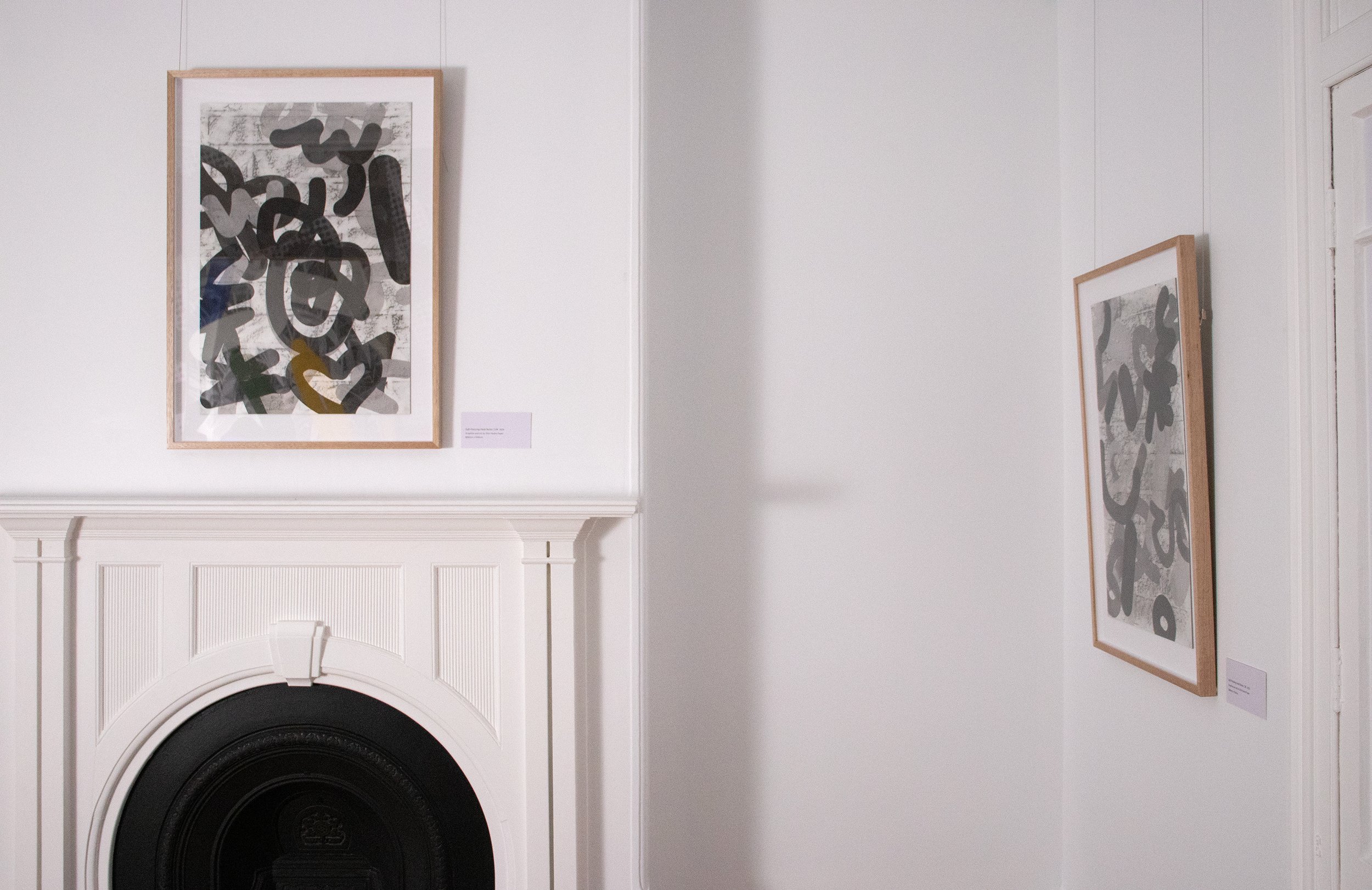




Shoalhaven Regional Art Gallery
13 July - 3 August 2024
Curatorial: Judith Blackall
Photographs by Simon Degroot


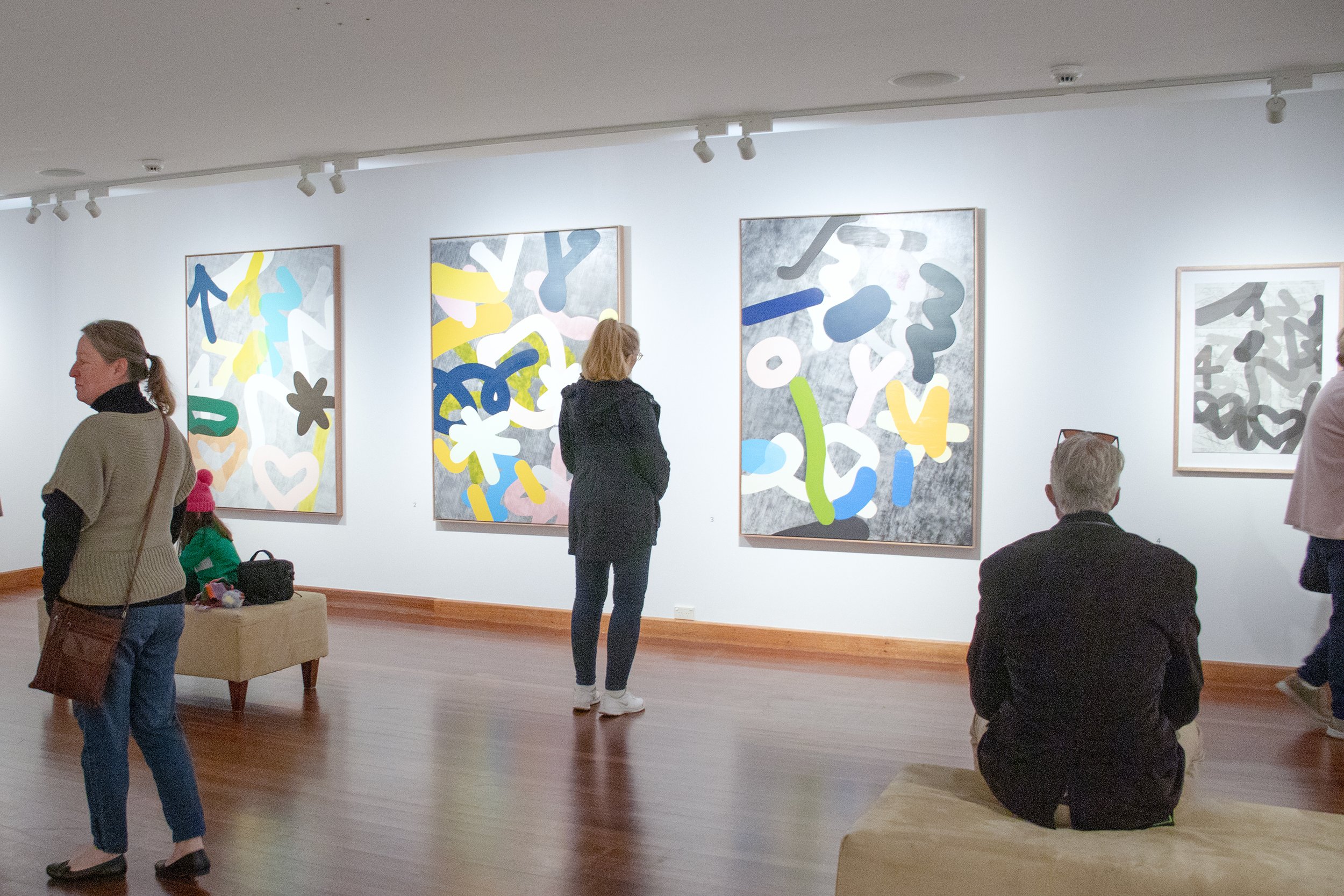

The Condensery
14 September - 17 November 2024
Curatorial: Madeline Brewer
Photographs by Jim Filmer






Redland Art Gallery
13 October - 26 November 2024
Curatorial: Kyle Weise
Photographs by Louis Lim and Mai Naito





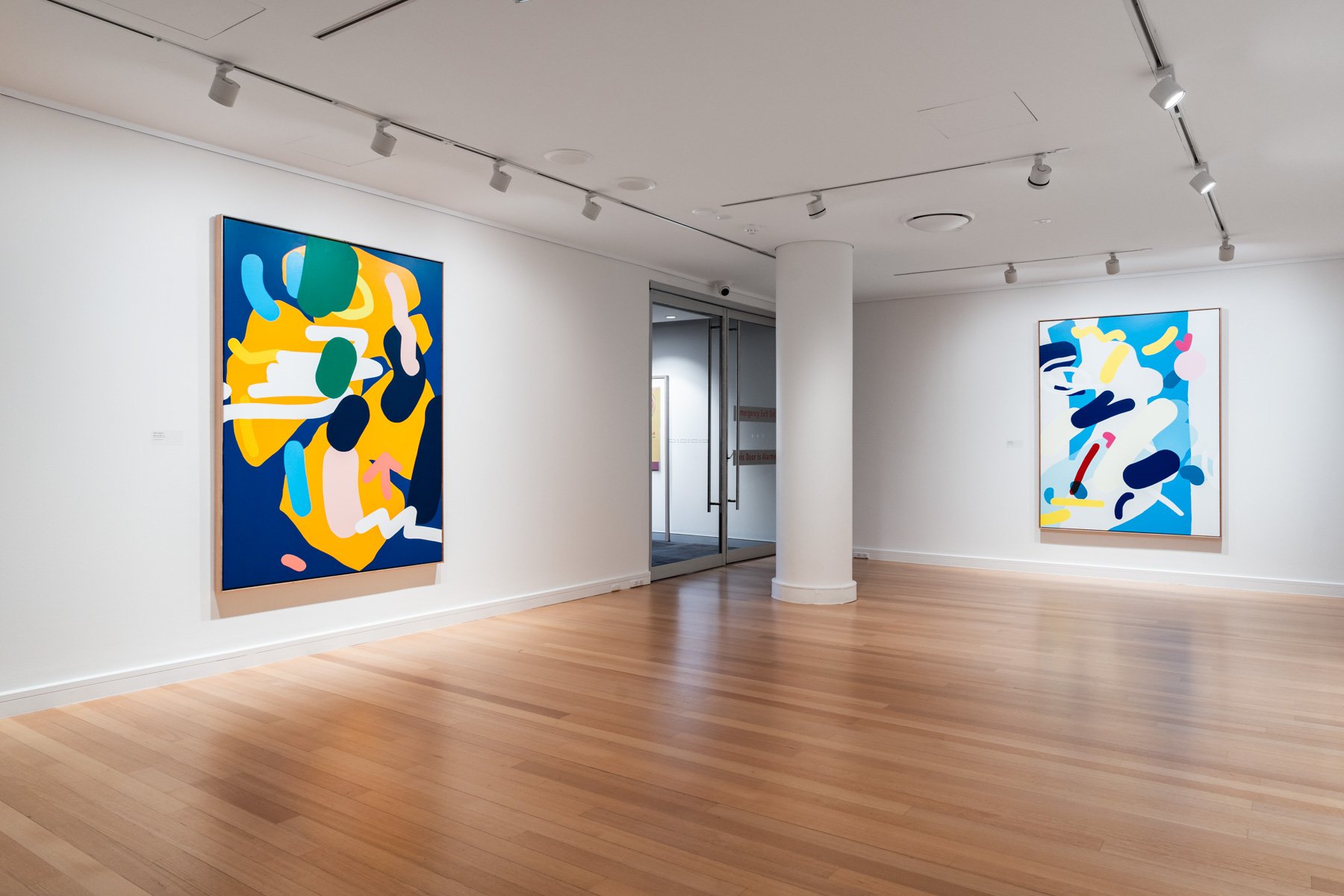
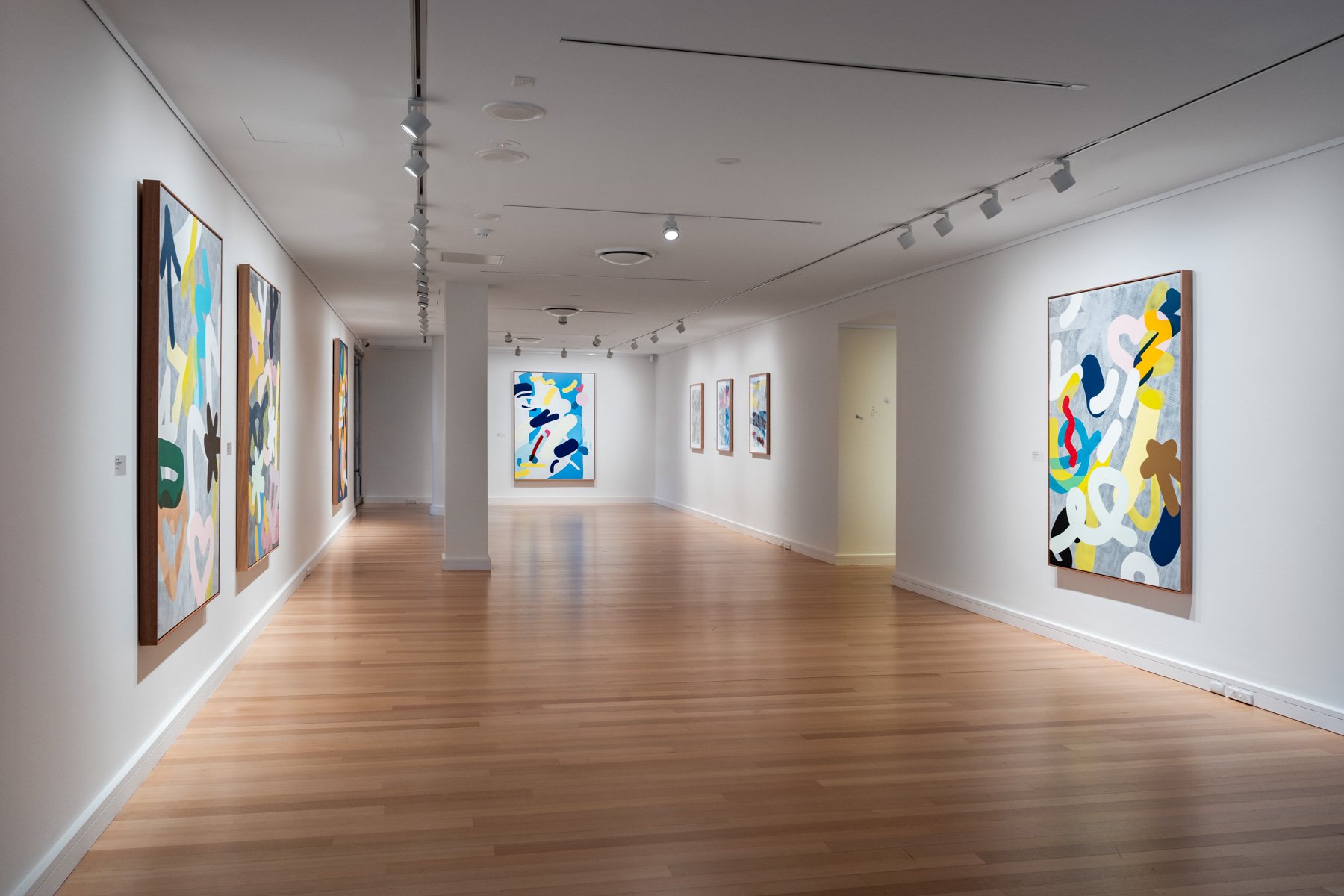

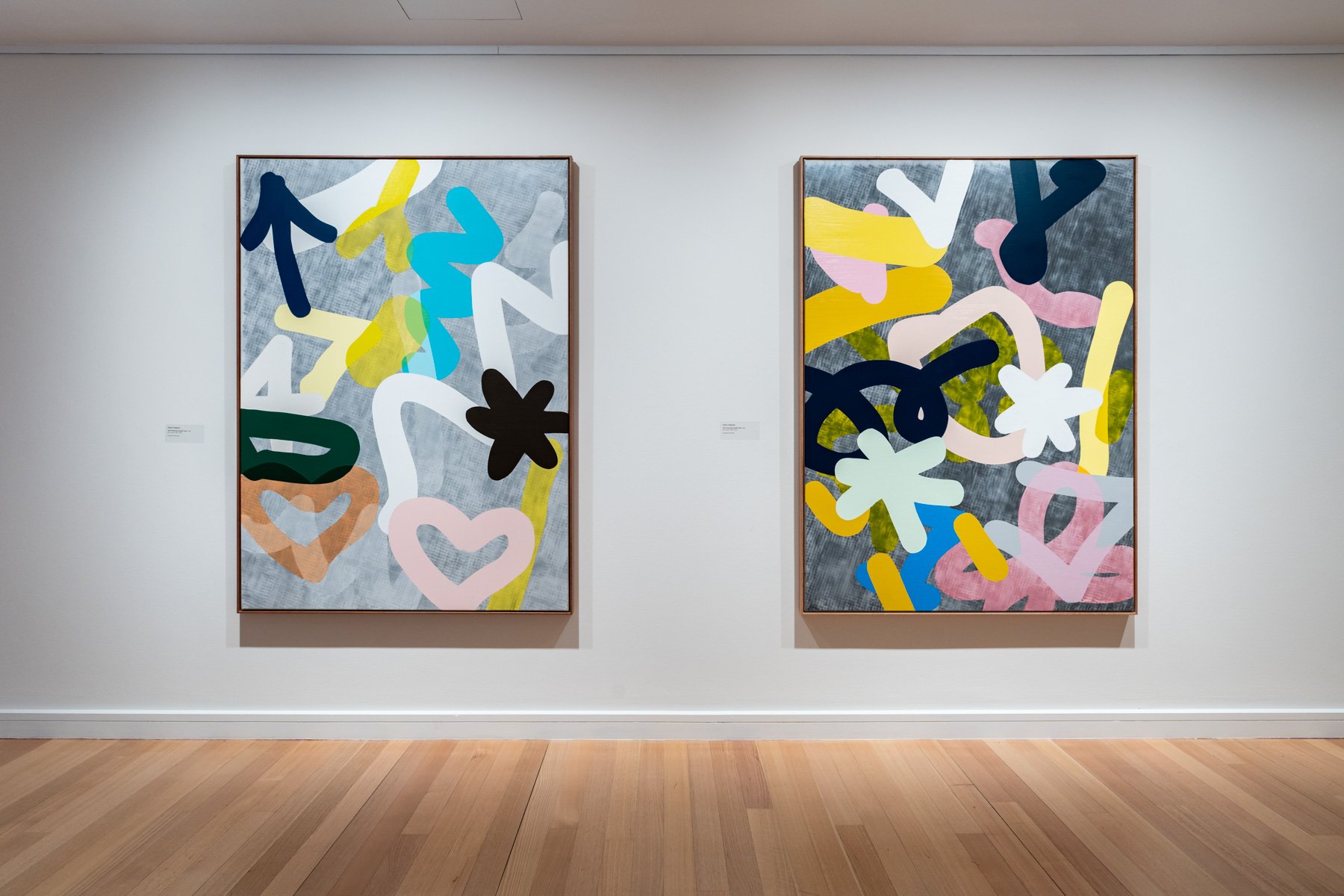







SOFT PRESSING
Kyle Weise
Soft Pressing is a dynamic exhibition of recent works by Simon Degroot that use abstraction to engage with the urban environment, where lines and patterns waver between play and purpose, observation and action.
For many of these works, realised on both paper and canvas, ‘frottage’ is an important starting point. This modest and immediate technique transfers textured surfaces to paper via rubbing with graphite or charcoal. The textures of bricks, tread plates, breeze blocks, utility access covers and other details of streetscapes have been captured in this way to form a ground for the works, bringing the hidden textures of our surroundings into pictorial visibility. Frottage expresses a purposeful moment of direct and intimate contact with the spaces around us, alongside an openness to chance, with the captured textures being determined by unseen surface details, rather than the intention of the artist.
Degroot has previously used shapes drawn from the urban environment as the basis of works, digitally manipulating these before their translation onto canvas.[1] For the works here, using frottage, his contact with this urban context is more familiar, almost affectionate, as he captures the crevices and forms of these everyday, often ignored, surfaces. Public murals are an important aspect of Degroot’s work, painted onto facades and materials typical of streetscapes, including Besser Blocks (Flow Through, 2019), concrete slabs and formwork (Nundah Mural, 2015), and bricks, pipes and window frames (Puzzle Innovate Solve, 2019). Soft Pressing is almost the inverse of these public works, as Degroot uses frottage to distill the form from such surfaces, instead of covering them with paint, replicating and transposing what his work would usually cover. Both, however, are based on a tactile relationship to these spaces, and both are structured by existing built determinations: whether this is the size of a building wall or the pattern of a telecommunications pit lid.
In their writing on frottage, both Maya Pindyck and Margaret Iversen emphasise that this process suppresses personal expression. Instead, they argue, frottage opens itself to contingency and to a tactile engagement with the world that moves beyond intention.[2] Iversen presents an overview of various contemporary artists who use frottage in distinct ways, both materially and conceptually. Despite the differences, a connecting thread across these artists’ work can be discerned in the connections many of them make between frottage and memory. This isn’t necessarily the memory of the artist, but rather memories subsisting in the material world. Writing on Masao Okabe’s work, Iversen writes: “Etched into the surfaces of the city are indelible traces of the past which are revealed through the intimate process of frottage.”[3] Similarly, Degroot’s frottages bring to visuality a moment in the life of these urban surfaces. Marked by a multitude of forces, including weather, plants and humans, these objects and facades are not static or inert but, like all matter, ceaselessly changing within the flow of time, intersecting with humans but not determined by this.[4] Pindyck extends this idea further, suggesting that frottage is a collaboration with objects and is susceptible to their vitality. This is a perspective that opens itself to the agency of objects, as forces in the world not delimited by human intention or interaction. Jane Bennett, referenced by Pindyck, describes this as ‘thing-power.’
Inspired by an accumulation of debris in a gutter (pollen, a dead rat, a plastic glove, a bottle cap and a piece of wood), Bennett attempts to grapple with the shimmer of vitality in these discarded objects and their part in active assemblages that produce effects, both subtle and dramatic, in ways that exceed human contexts and meaning.[5] For Bennett, the human remains a part of the assemblage of things, but she emphasises that human agency is always “accompanied by a vast entourage of nonhumans.”[6] The human itself is enfolded into this concept and recognised as a material assemblage: a complex agglomeration of minerals, chemicals, and other organisms, ceaselessly flowing and combining in the formation of a ‘human.’[7] Bennett’s interest is not to displace the human but to democratise and expand the conception of the political, in which the human is understood as one (unexceptional) actor amongst many. Here the nonhuman multitude is no longer understood only from a human perspective (“misrecognized as context, constraint, or tool”)[8] but is recognised as having agency and as a temporal force in the world.
Bennett’s concept of distributed agency, which entangles the human as one active component among many, is captured eloquently in her description of riding a bicycle on a gravel road: “Agency is, I believe, distributed across a mosaic, but it is also possible to say something about the kind of striving that may be exercised by a human within the assemblage. This exertion is perhaps best understood on the model of riding a bicycle on a gravel road. One can throw one’s weight this way or that, inflect the bike in one direction or toward one trajectory of motion. But the rider is but one active operative in the moving whole.”[9]
Bennett’s example, and Degroot’s frottage technique, simply amplify processes that are endemic to our everyday navigation of the physical environment, which is a dynamic intersection of humans and things. The texture of the gravel, the brick wall and the metallic tread plate, is never settled, but intersects with the human to achieve a brief collaborative event amidst flows of time and material. The frottage that forms the background of the monochrome works on paper, Soft Pressing Field Notes (2024), retain a mimetic relationship to the source surfaces: ghostly copies of the streetscape. By contrast, the sources of the background frottage on the larger canvas works are unrecognisable, abstracted to soft undulating patterns. Across both series, Degroot overlays these textures with bold gestural strokes akin to enlarged and exalted versions of the scribbles, marks, inscriptions and marginalia found scattered and scrawled across the urban environment.
There is an apparent tension here. If frottage is the withdrawal of human intention, such urban marks, exemplified by graffiti and tagging, are generally understood as an expression of individualism and territoriality: an attempt to impose human meaning and control on an urban space in flux.[10] Furthermore, these marks invite semiotic reading, or decoding, often taking the shape of disguised words.[11] Indeed, the term ‘graffiti’ derives from the phenomenon of names and words being scribbled on ancient Roman architecture.[12] Degroot’s interpretation of these marks separates these from language, with enlarged details of lines and squiggles layered across the work.
These tangled shapes in Degroot’s work also recall the seemingly impenetrable language of utility markings, those multi-coloured spray-painted marks spread across footpaths and roads to facilitate construction. These markings create a temporary map of the invisible underground world of urban infrastructure.[13] Painted for pragmatism, utility markings often linger in various states of erosion long after they have served their purpose, becoming purely decorative, mysterious urban marginalia.[14] There is an excess to this ‘utility graffiti’, and to illicit graffiti, that is not contained by its intent, but reflects a multitude of forces and materials that determine its form, including, the texture of the inscription surface, the tools at hand, weather, traffic and so on. Abstracted from language and legibility, Degroot’s work accentuates this unclassifiable excess.
Soft Pressing emphasises the pure form, dynamism and immediacy of such marks and downplays their territorial connotations and semiotic allusions. Catching the train home from the Redland Art Gallery each day, the view through the window is obscured, or modified, by etches and scratches made over the years by fellow travellers. The urban environment is not unique in this feature. Having had Soft Pressing on my mind, I have started to notice these inscriptions everywhere, on walls, street furniture, poles, even in the middle of national parks, on lookout barrier posts or on information signs about the local wildlife. Once you start to look, it seems like such markings and illicit inscriptions are ubiquitous and inescapable, from doodles on library books [15] to the surfaces of ancient relics in Pompeii. [16] There is, it seems, a compulsion to mark places, but the style of these, their scratched lines and rough lettering is often determined by the materials and surfaces at hand; hastily scrawled, they exceed legibility. By framing, abstracting and amplifying the squiggles and lines that inhere in the marks, inscriptions and marginalia of our environment, Degroot sheds their territoriality to capture the dynamism of these forms.
The capacity for play expressed in Degroot’s work emphasises the immediacy of these strokes, not as an assertion of authorship or control, but instead as an opening to spontaneous gesture: following a doodle or a scrawl and seeing where this takes us. Instead of interpreting these phenomena in terms of the assertion of individual presence or individualistic expression Degroot finds in these forms an openness to the unknown, a collaboration with the materials and surfaces of inscription: a spontaneity of stylus, surface and mark. Degroot’s work expands and celebrates these urban surfaces and their marks and interruptions, and Soft Pressing can be understood as an open-ended call to making and to finding our own paths and stories within urban space.
The colours and forms in Soft Pressing draw from the urban environment, but also accumulate nods to art history, another context in which Degroot encourages us to find our own way; to see the ‘masterpieces’ of art history as another surface to be played with and made our own, rather than to be calcified by distanced adoration. Two works in this exhibition emphasise this: Notes on Matisse (2024) and Notes on Kelly (2024). Here, instead of frottage, versions of Henri Matisse’s and Ellsworth Kelly’s works form the background of each respective painting, which is then overlaid with lines and squiggles. In Soft Pressing, art history becomes, like the urban environment, a mutable surface, rather than an object of reverence.
Matisse’s declining health in his later life led to a more relaxed form of making, where he would work quickly and directly, creating numerous works using just scissors and painted paper. It is one of these cut-outs that forms the basis of Notes on Matisse. A bold impression of a mandarin peel painted by Kelly, a renowned abstract painter, forms the background of Notes on Kelly. Kelly, himself influenced by Matisse, seems a particularly important reference here. Although Kelly would almost never make lines or marks, instead focusing on large shapes of colour, his work connects to Degroot’s interest both in the urban environment and in introducing an element of chance, or the unintentional, into his work. Several of Kelly’s early notable works in the 1940s drew their shape and inspiration from everyday urban structures that he was familiar with, including windows and awnings, made in the wake of urban wanderings. Furthermore, Kelly would also introduce aleatory elements into his work, to let authorial intention recede for the sake of play. Several of Kelly’s most important works, such as Colors for a Large Wall (1951), are grids of colour whose composition is based entirely on chance: “a painting in which no aspect of its appearance has been determined by the artist’s personal choices.”[17] The influence of both artists extends across all of the works in Soft Pressing, in the plays with form and shape, balancing impromptu gestures with meticulous realisation.
Frottage connects us to the layers and stories of the city. The collected textures of frottage form the background of many of Degroot’s works in this exhibition, over which are layered shapes, lines and scrawls that create a palimpsest of processes and references, wavering from found doodles to lauded figures in art history. In this way Soft Pressing offers a celebratory recognition of the way that creative expression is realised through swirling flotsam of response, influence, material contexts and distracted gestures as much as through the directed intention of the maker.
- Kyle Weise
Endnotes
Hamish Sawyer, “Simon Degroot: The Aesthetics of Translation” Simon Degroot: Constructive (Caboolture Regional Art Gallery, 2020).
Maya Pindyck, “Frottage as Inquiry” International Journal of Education Through Art 14.1 (2018): 13-25. Margaret Iversen,“Indexical Drawing: On Frottage” A Companion to Contemporary Drawing Ed. Kelly Chorpening and Rebecca Fortnum. Wiley Blackwell Companions to Art History 20 (Chichester: Wiley Blackwell, 2020): 257-70. Thank you to Simon Degroot for providing these (and many other) references that contributed to this text.
Iversen, 262.
See Jane Bennett on Henri Bergson: Jane Bennett, Vibrant Matter: A Political Ecology of Things (Durham: Duke University Press, 2010): 77, 92.
Ibid., 4-6.
Ibid., 108.
Ibid., 10-13, 92, 120-21. James Bridle’s recent work, also interested in sidelining human exceptionalism, is especially relevant to this idea. Bridle presents an overview of recent developments in biology that question the stability of a clearly defined ‘human,’ via DNA links to other species. Also crucial for Bridle is the awareness of symbiosis, rather than competition, as the defining feature of the evolution of, and relationship between, organisms, including the human. James Bridle, Ways of Being: Beyond Human Intelligence (London: Allen Lane, 2022): 84-112.
Bennett, Vibrant Matter, 108.
Ibid., 38.
See: David Ley and Roman Cybriwsky, “Urban Graffiti as Territorial Markers” Annals of the Association of American Geographers 64.4 (1974): 491-505; Daniel D. Gross, Barbara Walkosz and Timothy D. Gross, “Language Boundaries and Discourse Stability: ‘Tagging’ as a Form of Graffiti Spanning International Borders” ETC: A Review of General Semiotics 54.3 (1997): 275-85. Esp. p.276-77, 283.
Daniel D. Gross and Timothy D. Gross, “Tagging: Changing Visual Patterns and the Rhetorical Implications of a New Form of Graffiti” ETC: A Review of General Semantics 50.3 (1993): 251-64.
Keely B. Harris, “Graffiti as Public Pedagogy: The Educative Potential of Street Art” Metropedagogy Power, Justice and the Urban Classroom, Eds. Joe Kincheloe, Kecia Hayes (Rotterdam: Sense Publishers, 2006) 97-112. p.98. In a noteworthy dovetailing of frottage and graffiti, frottage has been technique used by archaeologists to document ancient graffiti, see: Riccardo Valente and Luigi Barazzetti, “Methods for Ancient Wall Graffiti Documentation: Overview and Applications” Journal of Archaeological Science: Reports 34 (2020): 1-13.
For a brief overview and history of these utility markings, see: Jimmy Stamp, “Decoding the City: The Road Graffiti Placed by Utility Workers” Smithsonian Magazine 16 Apr. 2013: <https://www.smithsonianmag.com/arts- culture/decoding-the-city-the-road-graffiti- placed-by-utility-workers-42822014/>.
A relatively amusing newspaper article from 2012, relays the concerns of disgruntled Fort Lauderdale residents complaining that there was too much ‘utility graffiti’’ in their neighborhood. Residents quoted in the article claim that that some of the workers took too much “artistic licence” and “went crazy” with their utility markings. The article notes that the time it takes for such markings to disappear “can depend on the amount of rain, traffic and sunlight.” See: Larry Barszewski, “Long-lasting ‘utility graffiti’ has some residents grumbling” Sun Sentinel, 21 June, 2012: <https://www.proquest.com/ wire-feeds/long-lasting-utility-graffiti-has- someresidents/docview/1021838275/se- 2?accountid=14723>.
See, H.J. Jackson, Marginalia : Readers Writing in Books (New Haven: Yale University Press, 2001).
Rhea Nayyar, “Tourist Detained After Vandalizing Ancient Pompeii House” Hyperallergic 24 June, 2024 < https:// hyperallergic.com/928503/tourist-detained- after-vandalizing-ancient-pompeii-house-of- ceii/>.
https://www.moma.org/collection/ works/80528. On the elements of Kelly’s work discussed, see also the MoMA page dedicated to the artist: https://www.moma. org/artists/3048. For Kelly’s reflections on this early work, see: JenniferSmith, “Ellsworth Kelly, 92, Nails Down His Earliest Work” Wall Street Journal 17 July, 2015:<https://www.proquest.com/wire- feeds/ellsworth-kelly-at-92-nails-down- hisearliest/docview/2065964198/se- 2?accountid=14723>.



